AVADirect Clevo P170EM: Has AMD’s HD 7970M Got Game?
by Jarred Walton on October 2, 2012 1:35 PM ESTBattery Life and Power Draw
If we discount the overall design and build quality, so far we’ve seen very good performance from the P170EM with some nice LCD options as well. As noted earlier, however, battery life is not one of the strong points of Clevo in general, and the P170EM falls far short of the competition. We’re dealing with an Enduro equipped notebook, so when the dGPU isn’t being used it’s totally powered off—and the same goes for the Optimus version. If we take the Samsung Series 7 and Alienware M17x R4 as our baselines for what to expect from a 17.3” notebook and factor in battery capacities, the P170EM and its 77Wh battery ought to be able to deliver somewhere between 293 to 439 minutes of idle battery life. The Alienware M17x actually isn’t all that optimized for power use, while the Samsung Series 7 is clearly tuned for power savings when set to the “Power Saver” profile. We set the P170EM for ~100nits (28% brightness in this case, which actually results in around 130nits—the next step down at 14% brightness gives 70nits, so we opted for a slightly brighter display) and ran our standard battery life tests…

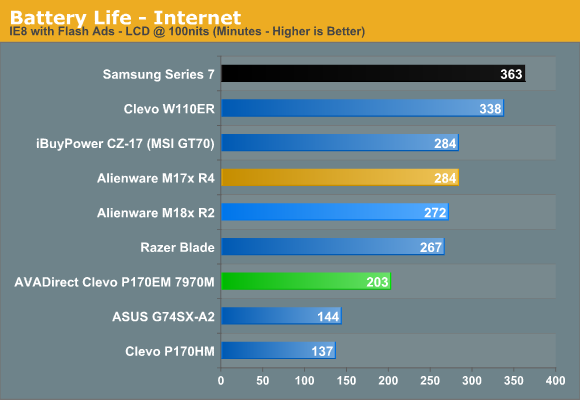

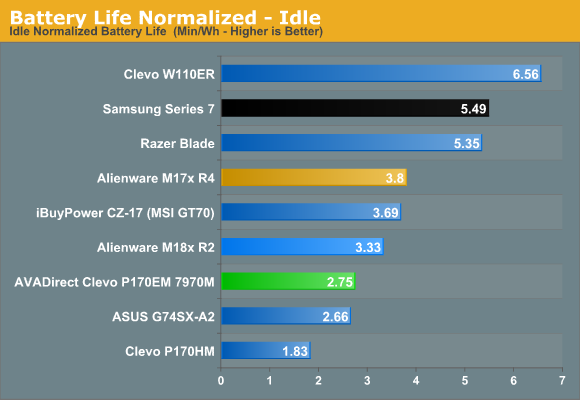
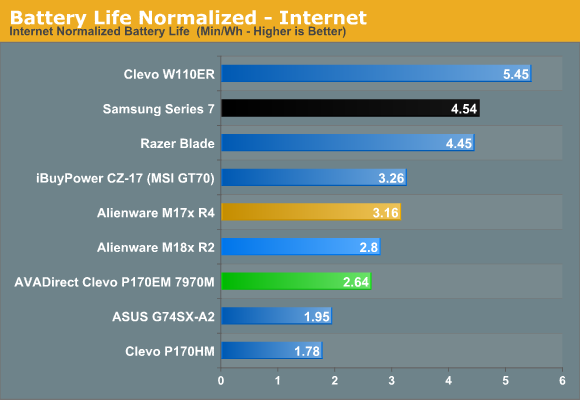
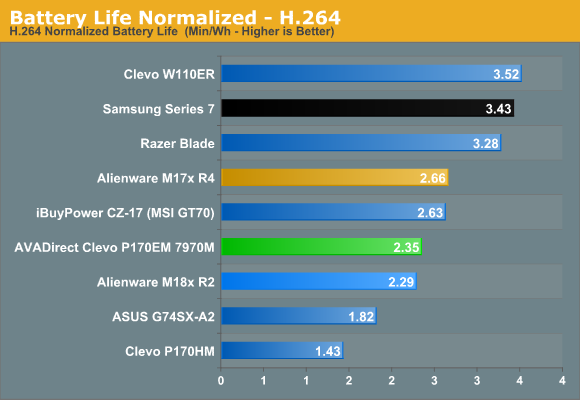
…And that’s what you get when a company doesn’t pay much attention to tuning a design for lower power use. What’s shocking is that the difference between our best-case Idle test and our worst-case H.264 test is only 31 minutes (17%); on the Alienware the difference between those same test results is 43% while on the Samsung it’s a whopping 60% difference. I’m not sure exactly what Clevo is or isn’t doing here; I’d assume some of this is just firmware/BIOS code, but it could be the motherboard capacitors, fans, routing of signals, etc. is simply not done efficiently. More to the point, it almost looks as though the dGPU isn’t powering down properly when it’s not being used. I have no way to really confirm that, but I would estimate the dGPU would use at least 10W of power at idle and that’s basically the difference between the P170EM and the Samsung.
If you really want to punish the battery, you could even try to run a game while unplugged. We set the system to the “Balanced” profile but set AMD’s PowerPlay to “Maximize Performance”, which basically means don’t limit the GPU clocks even if you’re on battery power. You basically get full gaming performance with these settings, but the battery only manages ~40 minutes before going dead. Not that we expect any better—we’re talking about a 45W TDP CPU and somewhere around 100W TDP for the HD 7970M, plus all the various other devices. All told, the estimated power draw for such a load is around 160W, and our real-world testing gives us a power draw of around 115W.
Thermals and Noise
Battery life is a pretty serious disappointment, even for Clevo, but there are still some good elements to discuss. As big and bulky as the P170EM chassis is, you’d expect some good thermals—and it delivers. We ran the same stress test that we used on the Dell XPS 15 and Samsung Series 7—looping the x264 2nd Pass encode on six of the CPU cores while playing Batman: Arkham City at max details on the remaining two cores—and recorded CPU and GPU clocks. Unlike the Dell and Samsung offerings, we saw no evidence of CPU or GPU throttling with the P170EM. Here are the charts of the CPU/GPU clocks and the CPU/GPU temperatures during our two hour stress test, plus a screenshot from HWMonitor:
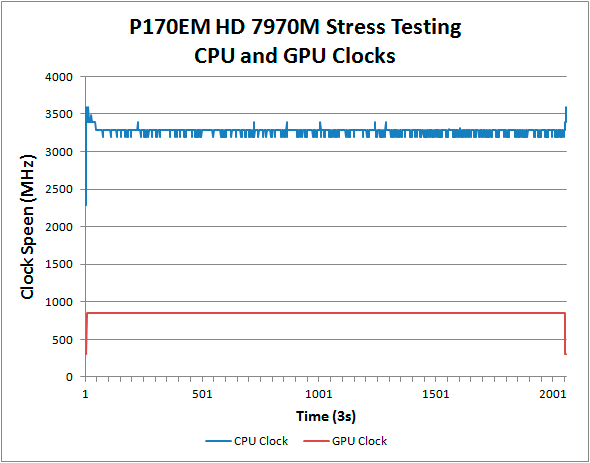
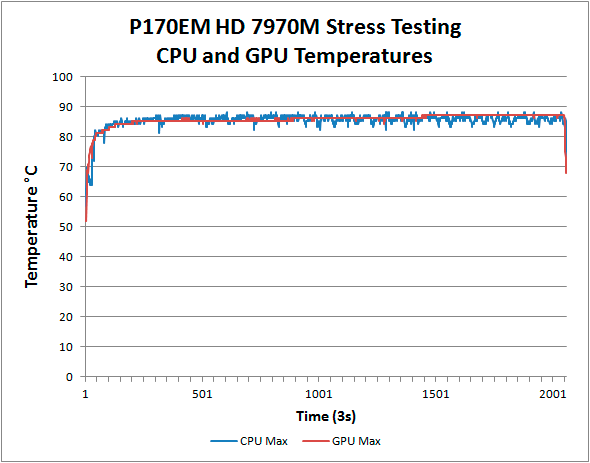
The maximum CPU temperature during our torture testing reaches 88C, which is quite good for a notebook running a high-end CPU like the i7-2720QM. Likewise, the maximum temperature on the HD 7970M is 87C. Those temperatures might not seem all that great until you consider that we’re running at 100% load for two hours with no throttling below the expected maximum turbo clocks (e.g. 3.2GHz on the CPU with all cores active). Clearly the large heatsinks, fans, and exhaust ports are doing their job, though they’re not particularly quiet.
At idle the acoustic noise measures 33.6dB from ~18 inches in front of the P170EM, under 100% CPU load the noise output reaches 38.7dB, gaming pushes the second HSF into action and we get 40.2dB, and during our full stress test we measure 42.4dB. While the idle and load noise levels are noticeable, the character of the noise isn’t all that bad, with a lower whooshing sound thanks to the size of the blower fans. Perhaps more importantly, there’s still another level of fan speed that we didn’t reach during our normal testing; when we set the laptop on our moderately shaggy carpet and covered the exhausts with our hands, after a few minutes of stress testing we were able to hit temperatures on both the CPU and GPU above 90C. The two fans operate independently, and when the CPU hit 90C the noise level jumps to 42.8dB; get the GPU to 90C as well and we get a worst-case noise result of around 46dB. Sure it’s loud at that point, but when the exhausts aren’t blocked the fans move a lot of air—it only took about five seconds after uncovering the exhausts for the temperatures to drop back down to the 85C range.










61 Comments
View All Comments
This_Account - Tuesday, October 2, 2012 - link
Hi, great article. It is a shame about the dual-link DVI though for sure.Quick question for you, does the USB 2.0 charge with the lid closed?
Cheers
JarredWalton - Tuesday, October 2, 2012 - link
I assume you mean with the laptop in sleep mode? As far as I can tell, there is no USB charging mode, so no it will not.hulawafu77 - Wednesday, October 3, 2012 - link
No. But on the right side, there are 3 USB 3.0. The first one is charging. It has a battery charge indicator on it to let you know.JarredWalton - Wednesday, October 3, 2012 - link
It's actually the left side with three USB 3.0 ports, and the front port does not have a charging symbol; rather, it has a USB symbol along with eSATA -- it's a combo port.MThorne74 - Wednesday, October 3, 2012 - link
... of laptop GPU performance. As pointed out, this thing has a user-upgradable GPU in it which allows you to swap out the graphics board much like you would on a desktop system. All you'd need is the 7970m and a 680m and whatever else you desire to compare. GPU focused performance comparisons would be much more precise then.JarredWalton - Wednesday, October 3, 2012 - link
We've got the same laptop with 680M; I'm just running the tests still and did this one first.hulawafu77 - Wednesday, October 3, 2012 - link
P150EMThis may be a shock to Anandtech, but many like myself appreciate the design of the Clevo. Metal = Weight. These machines already weigh plenty, so I personally and many others like me agree, Clevo choosing plastic is good. The plastic does not feel cheap to me and it is thick and robust. There is no flex on it. As for hinges, not sure what else you want. The hinges on mine are covered by the thickest plastic I've seen on any laptop. Nothing thin about it. There is no flex around the hinges on my machine. I don't know why this article exaggerates the build quality, reading this, most will think it's cheap feel. And it's far from that.
Next: Comparisons are idiotic. This is a gaming machine. This is not a professional workstation, though you can modify to be, but really without a proper professional IPS display, better off getting a Dell/HP/Lenovo. So why bother comparing to those, those machines are military grade certified. As for Apple, those machines are made to look pretty on your coffee table. Clevo aren't make table decorations like Apple is. They aren't selling to moms and women or men who worry more about how thin and pretty their machine is than the hardware it comes with. 650M is not by any stretch impressive. Most gaming machines are plastic. Few have some metal, but very little, sparing on just small details to give it some panache. The laptop that took the mobile gaming industry by surprise was the G73JH, and that was all plastic. But that told manufactures, gamers want understated, black matte cases. And Clevo delivers. Even the latest iterations from MSI have calmed down their appearance significantly since the G73's release.
I love matte look, I don't want shiny metal. I prefer the rubberized surface, but I could deal with a brushed metal. These notebooks can be configured to have no logos, branding at all, which is awesome. I am not a billboard for Clevo, Apple, Dell, Lenovo.
Cost: These notebooks are really expensive. People who buy Clevo, buy it for the cost/performance. If you want a sci-fi look, get a Alienware. You want bling, get a MSI. If you want a stealth toy look, get a Asus. You want a Apple clone cause secretly you are envious of Macheads, get a Razer Blade. There are plenty of choices. I'd rather Clevo keep costs low on the case and pack it with hardware, options.
I've been typing on this machine for a long time and think the keyboard just takes adjusting to. This keyboard you do need to press more in the center or bottom, if you press on the edges or top, chance of missing keys. But since I'm used to it, I have no issues with the keyboard and can type as precisely and quickly as I could with my old IBM Thinkpad.
Some of your complaints with the keyboard are because you from the perspective of a writer. That's a problem, because this is not a machine designed for writers, it's a gaming machine. Take for example your ire with Windows key. Clevo did that on purpose. They enlarge the CTRL button which is used very often by gamers, whether its CS:GO or SC2. The removed the Windows because gamers complained of hitting unintentionally and sometimes causing to switch to desktop out of the game. I don't use End/Home often, even when using Word Processor or InDesign. I don't think that's a concern for most gamers.
Going forward you may want to write more in context of gaming and perspective of gamers when it comes to Clevo. I'd bet if you were to budget conscious gamers what they were most concerned about, metal casing and eye catching design would be near the bottom of the list. As long as the machine was well built, robust, and sturdy, they will be satisfied. And the Clevo does that.
JarredWalton - Wednesday, October 3, 2012 - link
I disagree with most of your assessment of the build quality. ASUS has similar build quality and they charge quite a bit less (though they lack the top-end GPU options as well). Alienware has a combination of metal alloys (magnesium alloy possibly?) with plastic and the rubberized coating. Magnesium alloys are very lightweight, which is why they're used in higher end notebooks -- they're rigid, better than plastic, and about the same weight.The hinges aren't necessarily worse than other consumer laptops, but take a look at the ThinkPad hinges; they're not substantially more expensive to make, but I can tell you from experience that they last forever. I've used ThinkPads that are over seven years old where the hinges still hold up. The plastic covers are just that: covers. Look under them and you'll find a mediocre hinge. For the cost, I want it to have a hinge that I don't think is going to fail in a few years (or at least become very loose).
The keyboard still sucks, no matter how you want to mince words and try to say it's for gaming. The Windows key can be remapped/disabled easily enough if you want, and Clevo also has resellers that say this is a "mobile workstation" -- not that I really go for that classification, given the build materials and overall quality. Sure, the keyboard works, and yes I'm a writer, which is why I point that out in the text.
The fact is, a keyboard like the one on the Samsung Series 7 is better in just about every way. If Clevo took the same layout and had a look and feel similar to the Series 7, I wouldn't complain much, but it seriously feels like crap to me. If you don't care about keyboard quality, fine, but it's pathetic that a machine this expensive has such a lousy keyboard. MSI's keyboard has the same layout but feels worlds better. And it's funny you try to slag off my complaints about the lack of dedicated Home and End keys... but how often do you use Insert, Pause, or Scroll Lock? Literally, it's about a ten second fix from a design perspective (and yes, I know you can remap keys, but then the labels are wrong so it's better done by the manufacturer).
The Clevo is not a bad machine by any stretch; it's just not at the same level as some other gaming notebooks. If I were in the market, I'd wait for one of Dell's frequent sales and buy an Alienware M17x. It's just better in pretty much every way, with better support from the manufacturer as well. Clevo's support (particularly in the form of BIOS updates) is terrible -- they don't trust users to flash a BIOS, so they don't provide them. And yet, they have battery life that's just as bad as if they didn't bother with Enduro/Optimus. It's a half-baked attempt, no matter how you slice it.
The primary reason to buy a Clevo is because it's less expensive and more customizable than an Alienware, and it has fast hardware. I understand that's enough for most people, and hopefully after reading this review they'll be able to decide that for themselves.
To say that my comparisons are "idiotic" because I mention Samsung as a slower alternative with a higher build quality, or ASUS, MSI, and Alienware... well, you're entitled to your opinion, but considering you already purchased a Clevo I'd have to say your opinion is more than a little biased. I'm writing from the perspective of someone that has used and tested dozens of laptops just in the last year; I try to put all my reviews into that context and let readers know where a particular notebook ranks. The Clevo is one of the fastest (if not the fastest) gaming notebooks around. For the performance, the pricing is pretty reasonable (but not great). For the pricing the build quality and overall design is about on the level of a midrange consumer notebook, only with a thicker chassis and bigger fans. And the keyboard is still one of the worst I've used. Some people like Acer's old floating island keys too; the general consensus however is that they were terrible.
hulawafu77 - Wednesday, October 3, 2012 - link
Not really biased at all. My previous machine was a Asus G73JH and I like my Clevo more in every way, from the design, cooling, hardware, LCD, and even the keyboard.I think you should spend more time in the Clevo/Sager forum where people actually buy and discuss them. Your perspective on these machines and your preferences are pretty off base. I don't think you understand the market that Clevo is going for.
As for price, Sager beats MSI and Asus handidly. The base price for my machine with a GTX 675M is $1300. Asus can't beat that even with a GTX 670M, inferior hardware. Plus Asus is not upgradeable and can't even access the GPU easily.
As for Alienware's sales? Please, they can't come close to the price of Sager still. Unlike Allienware, you don't have to barter with a sales rep and Sager's discounts are 24/7 all year round. What discounts did I get with my Sager? $80 off+3% cash discount and free shipping on top of a price that already beat anything offered by MSI/Asus/Alienware for the hardware I specified.
As for comparisons I think I spelled it out pretty clear how idiotic they were. You were comparing to Dell and Lenovo. For one they build workstations that are military grade certified. And the XPS 15 is not a high end gaming machine, that is a boutique machine competing with other Mac clones. And the Samsung Series 7 is not in the same category with Clevo and Alienware. The only two companies that make sense to compare is Alienware and MSI. When it comes to dependability and having your machine last, no problems. These things are built like tanks, there are users who bought X7200 with HD5870s and now upgrading them to 7970s. That's damn good quality of build to me. 30% of laptops don't even last 3 years and for many expect their Clevo to last 5.
As for service on a Clevo? Unmatched, no one can beat Clevo. If you go with a Clevo builder Mythlogic, you won't get a more technical proficient, better interaction and service by ANY company. Mythlogic has repeatedly reach out to Clevo owners who weren't even their customers. All it takes is a few minutes to post on a forum and they are ready to help. Sager, yeah I had an issue, and it was free 3 day shipping both ways and laptop fixed in 2 days and returned, I had it back in 1.5 weeks. Give me a break about service. As for BIOS, yeah that's laughable. If you actually spent time on a Clevo/Sager forum you'd see every laptop has had countless BIOS updates. I've only owned this machine for about 4-5 months and I've already updated the BIOS 3 times. No BIOS updates? Who are you kidding. And if I bork the BIOS update? Clevo doesn't care, you get that fixed, no questions asked. That sure doesn't like they don't trust us. Far from it, to the point they will repair your notebook without question if you borked it with a BIOS update.
JarredWalton - Wednesday, October 3, 2012 - link
Where do I "compare" this with the XPS 15? I say there are laptops like XPS 15 and MacBook that do unibody aluminum, that it costs more, and that's it. You're trying to make comparisons that aren't really there, which just shows your bias all the more. And talking to people in the Sager/Clevo forums is again asking for biased feedback; sure, it's important to please those users, but the market for laptops is huge and Clevo targets a very small niche. All I've done is spelled out exactly how this design fails to cater to other desires, and you apparently can't accept that and resort to calling me "idiotic".Sure, the base price for your machine is $1300; the base price for an M17x R4 is $1500. That's a 15% difference in price, with better build quality and materials in my book, so yes it's close to the Sager pricing. When Dell runs a 10% off sale on it, it would be basically a wash in terms of pricing. Meanwhile the base price of the MSI from iBUYPOWER is $1371 (5% more), and I'd have no problem suggesting you spend $70 more to get the MSI chassis in place of the Clevo if you want a better keyboard. The ASUS also starts at $1400 (8% more), but with specs on many components that are higher than the base Sager. Clearly, you and I have very different views on what it means to "beat a price handily".
Sager or one of the other vendors may end up costing less most of the time, especially with upgrades, but spending 20% more on a high-end notebook isn't out of the realm of possibility. Plus if we're looking at features and extras, Alienware has the option in the BIOS to switch off Enduro/Optimus. That requires extra hardware on the motherboard, which costs money, and there are a lot of Clevo owners with 7970M that wish they had that feature right now.
Are BIOS updates available for Clevo notebooks? Yes. Are they supported by Clevo if they go wrong and you need to get it repaired? Sure, if it's under warranty. Do they provide them on their site to the general public? NO. So you have to go through unofficial channels to get a BIOS update, which may or may not work. Or if you want to prove me wrong, give me a link to the official places where these countless BIOS updates are available.
Hint: a thread on Notebookreview forums with modded BIOSes does not qualify: http://forum.notebookreview.com/sager-clevo/416916... -- just read the disclaimer: "Before reading this thread, please know that this thread should not exist in the first place. While the option to email your Clevo reseller and ask for the latest BIOS is considered now the official policy of obtaining the latest BIOS, it should be noted that Clevo is the only major notebook manufacturer that has such a policy. My opinion alongside that of other users which have posted in this thread is that a reputable notebook manufacturer like Clevo should make BIOS updates publically available." Yup, my comments about Clevo's lack of BIOS updates is laughable, just like your blindness.
I'm sorry if my review offended you and your decision to buy a Clevo. That wasn't the purpose, and I still don't think it's a bad system. It's just not great and it's not something I can recommend to people without some caveats. I spelled out my caveats quite clearly, listed things I feel could be improved, and all you've done is said, in essence, that you disagree with the areas I dislike. You can do so (and you already have with your wallet), but I think there are a lot of considerations to make before buying any $1500+ gaming notebook. Then again, I still do my gaming on desktops 95% of the time.